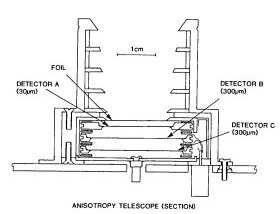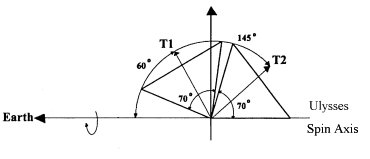 ATs Instrument Description
ATs Instrument Description ATs Instrument Description
ATs Instrument Description
The two Anisotropy Telescopes are identical solid state particle detectors with 70° opening angles and geometric factors of 0.7 cm2 sr. The figure to the left (Simpson et al., 1992)is a cross section through one of the telescope devices. Depending on the outputs of the the three detectors A,B and C, ions incident on the telescope will register a count in one of 13 data channels.
Different channels are sensitive to ions of different energies such that the ATs system is capable of measuring protons in the energy range 0.7-6.7 MeV. Helium, oxygen and sulphur nuclei can also be detected in some data channels but the instrument does not distinguish counts according to ion species.
The figure below shows a schematic view of the ATs instrument. The two
telescopes (T1 & T2) are mounted on the spacecraft at the angles shown
giving excellent angular coverage. Each time Ulysses spins about the axis
shown, the counts detected in some channels are separated into eight 45°
sectors. This means that each sector corresponds to a particular viewing
direction with a total of 16 viewing or look directions provided
by the two telescope system.

From these measurements we attempt to calculate if there is a directional dependence in the ion fluxes calculated from the count rates. If the ion flux is the same in all directions the ion distribution is isotropic, but, as the instrument name suggests, if the flux is larger in one direction than the others the ion distribution is anisotropic. The anisotropic nature of the fluxes helps us understand the underlying physics of space plasma media.
There is information on how we calculate the
anisotropy or you can go back to the ATs home
page.
ATs Home | Anisotropy calculation | ATs data channels | ATs publications | Ulysses home |